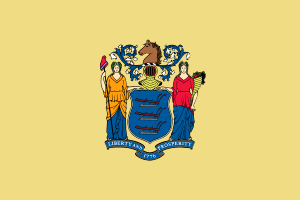Newark-Pompton Turnpike
| Newark-Pompton Turnpike | |
|---|---|
| Route information | |
| Existed: | 1806 – present |
| Highway system | |
The Newark-Pompton Turnpike (now known in portions of its former route as Pompton Avenue, Route 23, and Bloomfield Avenue), is a roadway in northern New Jersey that was originally a tolled turnpike. The roadway was first laid out in the mid-18th century and given its name in 1806. As originally designed, it connected Newark with the area north and west of the Pompton River in what is now Riverdale. Its south end is Broadway in Newark; its north end is the Paterson-Hamburg Turnpike. As such, it was part of an alternate route between Newark and Paterson.
In 1917, the road was designated as part of New Jersey State Highway 8. After the 1927 New Jersey State Highway renumbering, part of the road became NJ 23, while another section became part of NJ 9 (now CR 506).
Charlie Barnet recorded the song Pompton Turnpike, which was written by Will Osborne and Dick Rogers, about the Meadowbrook, a swing era performance venue on Pompton Avenue in Cedar Grove, NJ. It is now a Macedonian Orthodox Church. The song was covered as a jazz/blues vocal version by Louis Jordan, the "King of the Jukebox" in the 1940s.
President Grover Cleveland was born in a small house on Bloomfield Avenue just west of the Pompton Avenue intersection. The house exists today in its original condition as a tourist attraction in Caldwell.[1] Cleveland's father's church stands a few tenths of a mile down Bloomfield Avenue from Cleveland's original home.
The road passes through the following New Jersey communities:
- Newark: Bloomfield Avenue (CR 506 SPUR)
- Belleville: Bloomfield Avenue (CR 506 SPUR)
- Bloomfield: Bloomfield Avenue (CR 506 SPUR)
- Glen Ridge: Bloomfield Avenue (CR 506 SPUR, CR 506)
- Montclair: Bloomfield Avenue (CR 506)
- Verona: Bloomfield Avenue (CR 506), Pompton Avenue (NJ 23)
- Cedar Grove: Pompton Avenue (NJ 23)
- Little Falls: Newark-Pompton Turnpike (NJ 23)
- Wayne: Newark-Pompton Turnpike, NJ 23, Newark-Pompton Turnpike (County Road 683, CR 504)
- Pequannock: Newark-Pompton Turnpike (CR 504, County Road 660), NJ 23
- Riverdale: NJ 23, Newark-Pompton Turnpike (CR 511 ALT)
To follow the road in Wayne, it is necessary to turn right immediately after crossing the Passaic River from Little Falls, cross under a railroad trestle, and turn left. NJ 23 bypasses this short stretch of the old road. Unfortunately, it is impossible to return to NJ 23 at the north end of this short stretch.
History
In 1806, Israel Crane, a prominent businessman closely associated with the development of Montclair and Bloomfield, obtained a charter on February 24, 1806 from the state to build the private road, in the name of the "Newark and Bloomfield Turnpike Company".
Israel Crane eventually became the sole owner of the stock, and the sole operator of this toll road known as the Newark-Pompton Turnpike, which opened with four toll gates at Newark, Montclair, Pine Brook, and Singac. Because of his exclusive control of the turnpike, he was given the title "King Crane."
The "Newark and Bloomfield Turnpike" made the markets of Newark and New York accessible to the farms in the northern and western portions of New Jersey. With this improved transportation Bloomfield and Montclair became commercial centers, with taverns, wheelwrights, blacksmiths and wagon makers.
In 1870, the executors of Mr. Crane's estate sold the Turnpike to the Essex County Road Board. They widened, graded and macadamized the now public highway, and gave it the name of Bloomfield Avenue.
Between 1933 & 1935, the Newark-Pompton Turnpike was built into a four-lane undivided arterial to connect with US 46. This was the section north of Route 46 in Wayne up to what is now the exit (Overpass) by the present NJ Transit Route 23 Park/Ride Lot. A new alignment of Route 23 then continued north, removing the state highway from the rest of the Newark-Pompton Turnpike (except for a short ½ mile stretch in Pompton Plains and Riverdale). The Highway continued on a new alignment north through Riverdale, Butler & Kinnelon, connecting to the Paterson-Hamburg Turnpike in what was once known as Smith's Mills in West Milford.
During the 1980s, NJ 23 was upgraded from an outmoded arterial to a modern freeway with service roads.
See also
 U.S. Roads portal
U.S. Roads portal New Jersey portal
New Jersey portal
References
- ↑ Grover Cleveland Birthplace, accessed June 18, 2006
External links
- A history of NJ Route 23
- Pictures of the Newark-Pompton Turnpike Bypass
- The Website of the Crane House museum